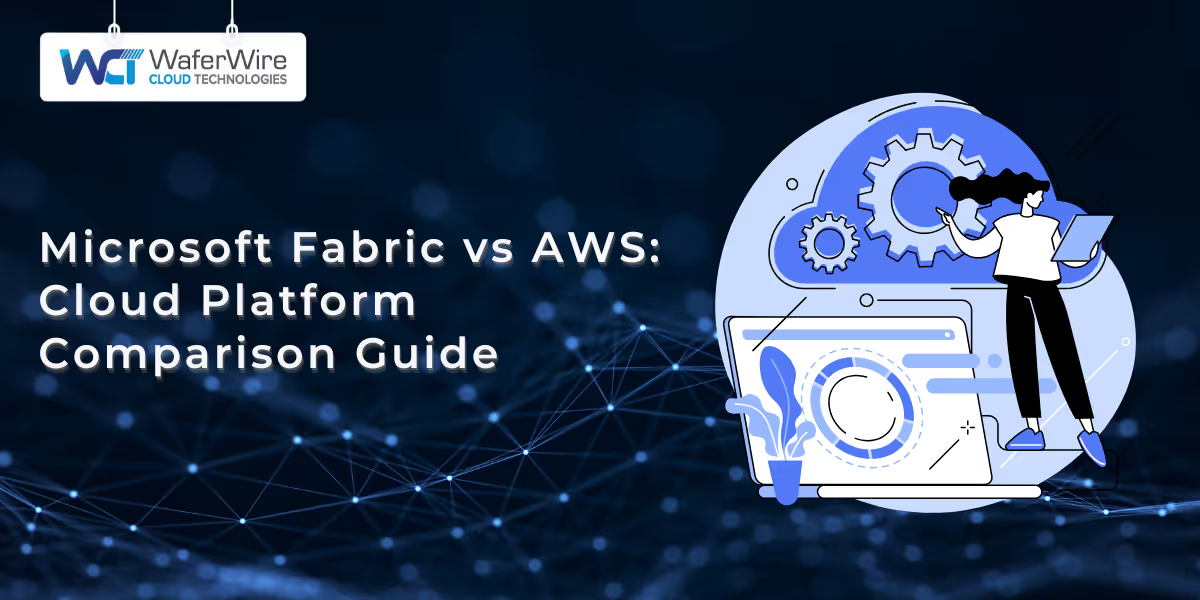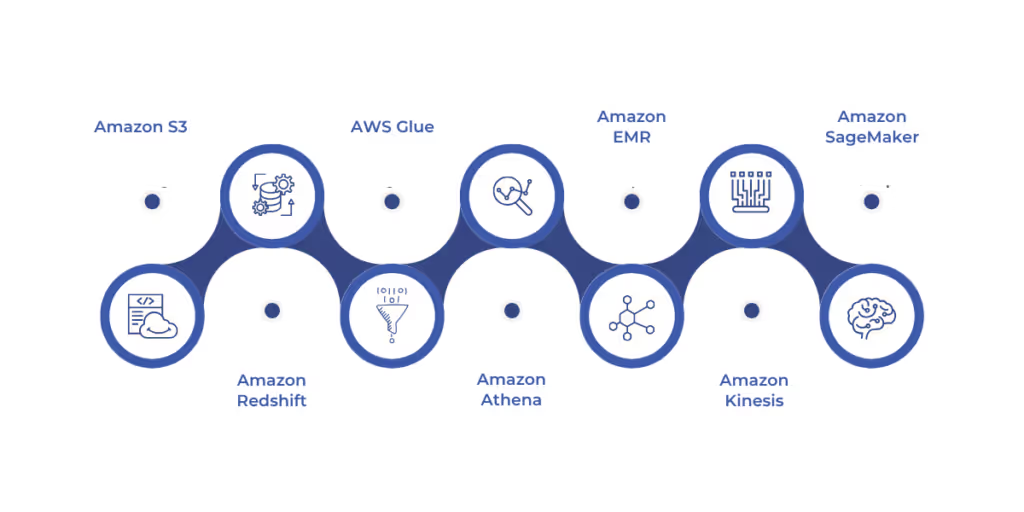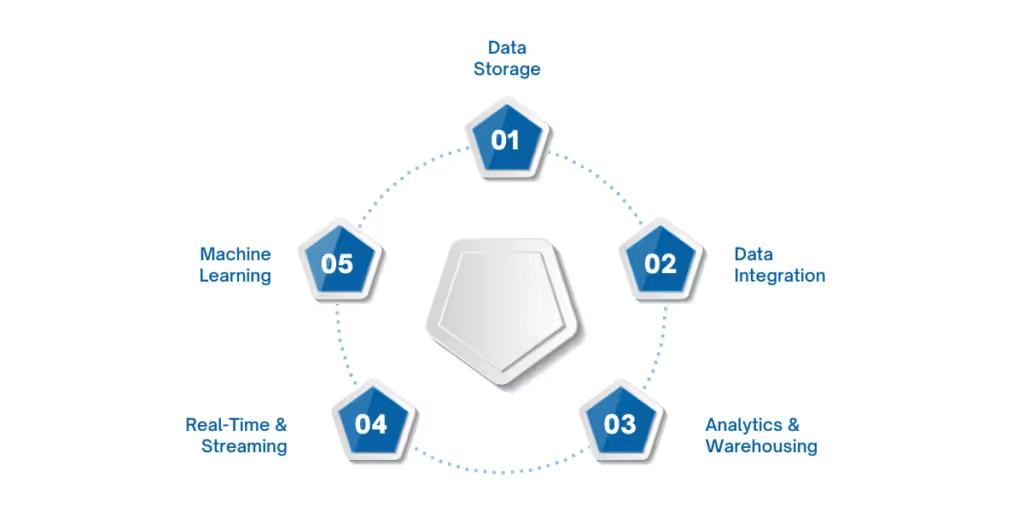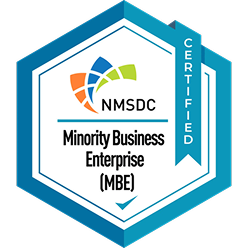

To keep pace with the growing demands of data management and analysis, businesses require scalable, integrated cloud analytics platforms. Two such leaders in the space are Microsoft Fabric and AWS, both of which bring unique benefits to address your analytics requirements. Microsoft Fabric provides a single, software-as-a-service (SaaS) platform that streamlines the analytics process by integrating data ingestion, engineering, warehousing, real-time analytics, machine learning, and business intelligence into a single solution.
Conversely, AWS offers a service-oriented, end-to-end cloud environment that includes more than 200 services, allowing you the freedom to design custom analytics workflows. Here, you'll learn how to compare these platforms along the most important dimensions, beginning with a summary of what each has to offer.
Before we get into the details, you should understand the foundational differences between Microsoft Fabric and AWS. In this section we'll cover what both platforms offer and how these differences will impact your experience working with data and analytics.
Microsoft Fabric is a unified, cohesive SaaS analytics platform, built for simplicity and integration. It will allow you to go through the entire data journey, from data ingestion to decision-making insights. Fabric offers a variety of integrated capabilities all within a single environment. Some of the main features of Microsoft Fabric, according to Microsoft's official documentation, are:
This unified approach allows you to take your raw data to insights without needing to work with multiple tools, which makes Fabric a great option if you like simplicity and continuity.

AWS (Amazon Web Services) is a broad cloud platform with a wide range of features and capabilities. AWS has more than 200 offerings across computing, storage, databases, analytics, machine learning, networking, etc. AWS allows us to build whatever solutions you can think of to meet your needs. Below are some AWS offerings that are critical regarding analytics.
AWS’s modular design gives you unparalleled control, though it requires more effort to stitch these services together compared to Fabric’s integrated model.
With a clear picture of each platform’s foundation, you’re ready to explore how their core services compare in delivering analytics capabilities.


The heart of any cloud analytics platform lies in its core services. This section breaks down how Microsoft Fabric and AWS stack up across five critical areas: data storage, data integration and ETL, analytics and warehousing, real-time and streaming, and machine learning and data science.
For Microsoft Fabric, data storage revolves around OneLake, a unified data lake built on Azure Data Lake Storage Gen2. OneLake provides a single, logical storage layer for all your data, whether structured, semi-structured, or unstructured. Microsoft documentation highlights its ability to eliminate data duplication by allowing all Fabric workloads to access the same data without moving it between silos. In a similar fashion to how a file system organizes data, you can store data hierarchically and take advantage of its integration with Azure’s security and scalability features.
AWS takes a different approach with Amazon S3 and Amazon Redshift. S3 serves as a highly durable object storage solution, perfect for storing vast amounts of unstructured data. Redshift is a data warehouse dedicated to structured data for analytical queries. S3 and Redshift are separate and powerful, but this separation means that if certain workflows require data movement between S3 and Redshift, you will need to manage this process, and this complexity does not exist in a Fabric's unified storage model.
When it comes to data integration and ETL, Microsoft Fabric offers Data Factory, a versatile service detailed in Microsoft’s documentation. Data Factory supports hundreds of connectors, enabling you to pull data from on-premises systems, cloud platforms, and SaaS applications. Its integration with Power Query provides a low-code interface, so you can transform data using a familiar, visual toolset without deep coding expertise. This makes ETL accessible to a broader range of users in your organization.
AWS counters with AWS Glue and AWS Data Pipeline. Glue is a serverless ETL service that automatically discovers and catalogs your data, then transforms it for use in analytics tools like Redshift or Athena. Data Pipeline, on the other hand, orchestrates complex workflows across AWS services and on-premises sources. While these tools are robust, they often demand more technical know-how to configure compared to Fabric’s intuitive, unified offering.
Microsoft Fabric’s analytics and warehousing capabilities hinge on its lakehouse architecture and SQL-based warehouse. The lakehouse, as described by Microsoft, merges the flexibility of a data lake with the structure of a data warehouse, allowing you to query both structured and unstructured data in one place. The SQL warehouse combines Apache Spark with the analytics capabilities and provides a high-performance analytic service that can support analytics workloads from reporting to data engineering.
With AWS, you have Redshift, Athena, and EMR. Redshift is the best at working with structured data for analytics. Athena enables you to perform analytics on data that you have in your S3 data lake without needing to provision a server. EMR enables you to do big data processing using Spark, Hive, and other processing engines. This variety gives you flexibility but requires you to choose and integrate the right tools for your use case, unlike Fabric’s all-in-one solution.
For real-time and streaming data, Fabric includes Real-Time Intelligence, a component Microsoft touts for its ability to ingest and analyze data as it streams in. This feature supports event-driven scenarios, such as monitoring IoT devices or tracking live transactions, and integrates seamlessly with Fabric’s other tools for immediate insights.
AWS relies on Amazon Kinesis, a suite encompassing Kinesis Data Streams, Data Firehose, and Data Analytics. These services allow you to ingest, process, and analyze streaming data at scale. While highly capable, Kinesis requires you to configure each piece separately, contrasting with Fabric’s more streamlined approach.
Microsoft Fabric offers built-in machine learning tools within its Data Science component, as per Microsoft documentation. You can develop models using popular frameworks like TensorFlow, and its integration with Azure Machine Learning provides advanced capabilities for training and deployment. This embedded approach ensures your ML workflows stay within the Fabric ecosystem.
AWS’s machine learning centerpiece is Amazon SageMaker, a comprehensive service for building, training, and deploying models. Supported by additional tools like Amazon Rekognition and Comprehend, AWS covers the full ML lifecycle. However, you’ll need to connect SageMaker with other AWS services, which can add setup time compared to Fabric’s integrated tooling.
Now that you’ve seen how their core services differ, let’s examine the architectural and integration aspects that shape your deployment experience.
The architecture and integration capabilities of a platform influence how easily you can build and scale your analytics solutions. Microsoft Fabric and AWS adopt contrasting strategies here, each with implications for your workflows.
Microsoft Fabric is an all-in-one SaaS solution. The official documentation highlights this end-to-end interoperability: you can consume data with Data Factory, process it with Data Engineering, and visualize it in Power BI without integration. This does minimize setup time and effort, allowing you to concentrate on analysis instead of configuration.
AWS utilizes a modular architecture, providing individual services such as S3, Redshift, and SageMaker that you attach as necessary. This gives you the ability to tailor your configuration, but it leaves you responsible for dealing with the integration and administration of those services, which may be a trade-off of control for ease.
Fabric shines across multi-cloud and hybrid scenarios, as it connects natively to data sources across cloud providers like AWS S3 or Redshift, as indicated in Microsoft's documentation. This functionality is a great way to facilitate analytics across disparate environments, and Fabric natively integrates hybrid support by also integrating on-premises data - which can be a big help if you're managing legacy systems.
AWS offers hybrid deployments with tools like AWS Outposts and Direct Connect, which just extend its infrastructure to your data center. However, cross-cloud analytics often has third-party solutions or custom integrations, where it becomes less straightforward than Fabric's native connectivity.
With architecture covered, let's approach how both of these platforms ensure that your data is secure while it is being compliant.
Security, governance, and compliance are critical for protecting your data and meeting regulatory demands. Both platforms excel here, but their methods differ.
Fabric provides unified governance and security through integration with Microsoft Purview, a solution Microsoft documentation praises for its data lineage, classification, and policy enforcement. You can use role-based access control to restrict permissions, apply sensitivity labels to protect data, and manage policies centrally across all workloads. Fabric aligns with standards like GDPR and HIPAA, using Azure’s compliance framework.
AWS offers robust security with AWS Identity and Access Management (IAM) for granular permissions, encryption options across services, and the AWS Key Management Service for key control. It meets global standards like GDPR and PCI DSS, with tools like AWS Artifact to document compliance. While powerful, you’ll need to configure these features across each service, unlike Fabric’s centralized approach.
Next, you’ll see how usability and user experience impact your team’s ability to adopt these platforms effectively.
How intuitive a platform feels can determine its success within your organization. Fabric and AWS cater to different user needs, reflecting their design philosophies.
Fabric is built for accessibility, featuring a visual, low-code interface that Microsoft documentation highlights as ideal for business users and data professionals alike. Power Query and similar tools let you perform complex tasks without coding, while AI-driven Copilot assistance offers smart suggestions to boost productivity. The unified platform minimizes navigation challenges, keeping your focus on insights.
AWS prioritizes technical users, offering an extensive command-line interface and a detailed Management Console. These tools provide deep control, perfect for developers and architects, but the breadth of options can overwhelm novices. AWS’s strength lies in its customization, though it demands more expertise to master.

Understanding the pricing models of Microsoft Fabric and AWS is crucial, as it directly impacts your budget and financial planning. Both platforms offer distinct approaches to billing, reflecting their design philosophies. Let’s break down how each platform structures its costs and what that means for your organization.
Microsoft Fabric has a capacity-based pricing strategy, as outlined in Microsoft's documentation. You buy capacity units shared with all workloads in Fabric, e.g., data integration, warehousing, and analytics. Billing is centralized, making cost management easier since you don't have to monitor each service's usage individually.
For instance, when you have a data pipeline running in Data Factory and querying a warehouse, both tasks share the same capacity pool. This approach is especially beneficial if you like to have predictable charges and an easy billing process. But for small businesses or workloads with extreme variability, it could be less economical than more granular pricing models.
AWS utilizes a pay-as-you-go pricing model that requires you to have costs assigned to individual services that you use. This model, outlined in AWS’s pricing documentation, offers flexibility, allowing you to scale each component independently. AWS pricing is well documented and provides flexible pricing and capacity models that allow you to change one capacity without impacting another.
More specifically, it allows you to grow your S3 storage with little consequence to your Redshift spend. AWS tools, such as AWS Cost Explorer and AWS Budgets, allow you to manage your business expenses, but for some organizations, having to manage multiple different service bills may be exhausting.
To summarize, Fabric's capacity-based pricing model eases the burden of budgets but may not allow for a specific level of cost control that you may see with AWS's pay-as-you-go model. Ultimately, the choice you make is dependent on the size of your organization, the predictability of workloads, and the way you prefer to manage finances. With pricing models in mind, let’s explore how each platform integrates with broader ecosystems and tools.
The ecosystem and tooling support of a platform determine how well it fits into your existing technology stack and workflows. Both Microsoft Fabric and AWS offer robust integrations, but their focuses differ based on their target audiences.
Fabric natively integrates with the Microsoft ecosystem, and as such, it's a natural choice if you're already on Microsoft 365, Teams, or Power BI. Microsoft documentation cites seamless connectivity with these products, allowing you to embed analytics into your day-to-day operations. For instance, you can directly share Power BI reports in Teams channels or automate workflows in Microsoft 365 from Fabric insights. This close coupling minimizes friction and maximizes collaboration throughout your business. Additionally, Fabric supports enterprise applications like Dynamics 365, allowing you to pull operational data into your analytics pipelines effortlessly.
AWS provides a mature ecosystem with native integration into AWS Lambda (serverless computing), Amazon SageMaker (machine learning), and AWS CloudFormation (infrastructure as code). With these tools, you can build highly customized solutions, especially if you’re developing large-scale applications or automating DevOps processes. In addition, AWS provides considerable support for third party tools and open-source frameworks, so you can exploit a range of technologies. However, integrating these services often requires more configuration compared to Fabric’s out-of-the-box connections.
If you’re deeply embedded in the Microsoft ecosystem, Fabric’s integrations will feel like a natural extension. Conversely, if you need a diverse set of tools and services for custom development, AWS’s ecosystem provides the breadth you’re looking for. Next, let’s consider the scenarios where each platform shines.
Deciding between Microsoft Fabric and AWS depends on your specific needs, technical expertise, and strategic goals. Here’s a guide to help you determine which platform aligns best with your organization:
For example, a mid-sized retail company looking to consolidate its data pipelines, analytics, and reporting into a single platform would find Fabric’s unified approach ideal, reducing complexity and speeding up time-to-insight.
A large e-commerce platform, for instance, might choose AWS to take advantage of its scalability and diverse services, customizing each component to handle massive traffic and complex data workflows.
Ultimately, your decision should reflect your organization’s technical capabilities, budget constraints, and long-term objectives. Both platforms are powerful, but they cater to different priorities. Let’s wrap up with a brief comparison table.
Before choosing between Microsoft Fabric and AWS for your analytics needs, it's helpful to see how the platforms compare side by side. The table below outlines their core differences across architecture, usability, integration, pricing, and more, making it easier to evaluate which solution aligns best with your technical and business goals.
Feature / CategoryMicrosoft FabricAmazon Web Services (AWS)Platform ModelUnified, end-to-end SaaS analytics platformModular, service-based cloud ecosystemStorage ArchitectureOneLake (centralized, ADLS Gen2-based), shared across all workloadsAmazon S3 (object storage) + Redshift (structured data); separate componentsETL / Data IntegrationData Factory with Power Query (low-code, visual interface)AWS Glue, Data Pipeline (developer-oriented, requires configuration)Analytics & WarehouseLakehouse + SQL-based warehouse + Power BIRedshift, Athena, EMR (requires separate setup and orchestration)Real-Time ProcessingReal-Time Intelligence (built-in streaming analytics)Amazon Kinesis suite (multiple tools for ingestion, analytics, and delivery)Machine LearningIntegrated with Azure Machine Learning; built-in ML tools within platformAmazon SageMaker, plus optional integration with EMR, Comprehend, etc.Governance & SecurityCentralized governance via Microsoft Purview (lineage, access, compliance)IAM, KMS, and service-specific security tools (must be configured individually)UsabilityVisual interface, low-code tools, Copilot AI assistance for business usersDesigned for developers; extensive CLI, APIs, and configuration flexibilityPricing ModelCapacity-based pricing (shared compute units across services; predictable billing)Pay-as-you-go (service-level pricing; granular but complex to track)Microsoft 365 IntegrationDeep integration with Power BI, Teams, Excel, and Dynamics 365Limited native integration with Microsoft toolsMulti-Cloud & HybridNative support for querying AWS S3, Redshift; hybrid-readySupports hybrid with Outposts & Direct Connect; multi-cloud requires custom setupBest ForSimplified, end-to-end analytics in Microsoft-centric environmentsCustom, large-scale solutions needing high flexibility and cloud-native tools
Microsoft Fabric and AWS represent two distinct approaches to cloud analytics. Fabric offers a unified, integrated platform that simplifies the analytics process, making it accessible to a broad range of users while ensuring governance and security. Its capacity-based pricing and tight integration with Microsoft tools make it an excellent choice for organizations seeking simplicity and cohesion. AWS, with its modular architecture and extensive service catalog, provides unparalleled flexibility and scalability, ideal for custom, large-scale solutions. Its pay-as-you-go model and global ecosystem cater to organizations with specific technical needs and a preference for granular control.
Your choice depends on your unique requirements. If you value an end-to-end solution with minimal configuration, Fabric is your go-to. If you need a highly customizable platform with a wide range of services, AWS is the better fit. To make the most of either platform, consider partnering with experts. WaferWire’s cloud specialists can help you implement and optimize your chosen solution, ensuring it aligns with your business goals. Contact WaferWire today to start your journey toward smarter, more efficient analytics.
Q1. How does Microsoft Fabric’s unified platform differ from AWS’s modular approach?
Microsoft Fabric integrates data ingestion, warehousing, analytics, and BI into a single SaaS platform, simplifying setup and usage for you. AWS’s modular architecture offers over 200 services, requiring you to configure each component, which provides flexibility but demands more technical expertise. For example, Fabric’s OneLake unifies storage, while AWS uses separate S3 and Redshift solutions.
Q2. Can you use Microsoft Fabric with data stored in AWS environments?
Yes, Microsoft Fabric supports multi-cloud connectivity, allowing you to access data in AWS S3 or Redshift without moving it. This native integration, as per Microsoft’s documentation, simplifies cross-cloud analytics. You can query AWS data directly, making Fabric versatile for hybrid setups compared to AWS’s reliance on custom integrations.
Q3. What makes Fabric’s pricing model easier to manage than AWS’s?
Fabric uses a capacity-based pricing model, where you pay for a shared resource pool across all workloads, simplifying budgeting. AWS’s pay-as-you-go model charges per service, offering granularity but requiring you to track costs across tools like S3 or Redshift, which can complicate financial planning.
Q4. How does Fabric’s usability benefit non-technical users compared to AWS?
Fabric’s low-code interface and AI-driven Copilot assistance make it accessible for business users, as noted in Microsoft’s documentation. You can create reports or pipelines without coding. AWS’s CLI and console tools cater to developers, often requiring more technical skills for effective use.
Q5. When should you choose AWS over Microsoft Fabric for analytics projects?
Choose AWS if you need a highly customizable platform for large-scale, multi-service applications. Its extensive services, like SageMaker and EMR, suit complex, developer-driven projects. Fabric is better for unified, low-code analytics with tight Microsoft ecosystem integration, ideal for simpler workflows.

